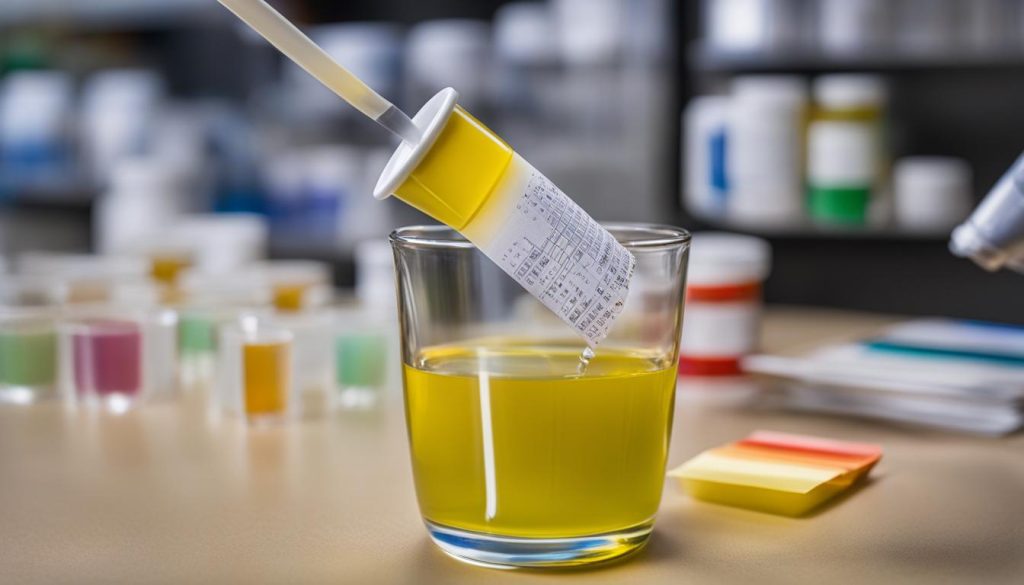
Welcome to our comprehensive guide on drug detection times in urine tests. As healthcare professionals, we understand the importance of accurate and reliable urine drug monitoring for detecting substance misuse or abuse, as well as ensuring adherence to prescribed regimens. In this guide, we will explore the various aspects of urine drug testing, including sample collection, specimen validity testing, immunoassay (IA) testing, confirmatory testing with gas chromatography-mass spectrometry (GC-MS), and the detection windows for different drugs.
Urine drug testing requires a minimum of 30 mL of urine, and specimen validity testing can detect dilution, adulteration, and substitution of urine samples. Immunoassay tests are commonly used for initial drug screening, but they can result in false positives and false negatives. Confirmatory testing by GC-MS is more accurate but more expensive and time-consuming. The detection window for drugs in urine varies depending on the substance, ranging from as little as 1-2 days to up to 12 weeks.
Key Takeaways:
- Urine drug testing is a vital tool for screening substance misuse or abuse and monitoring medication adherence.
- Sample collection, specimen validity testing, immunoassay testing, and confirmatory testing with GC-MS are important steps in urine drug testing.
- Immunoassay tests are commonly used for initial drug screening, but they can produce false positives and false negatives.
- GC-MS testing is more accurate but more expensive and time-consuming.
- The detection window for drugs in urine varies depending on the substance, ranging from 1-2 days to up to 12 weeks.
Importance of Urine Drug Monitoring
Urine drug monitoring plays a crucial role in identifying and addressing substance misuse and abuse, as well as ensuring adherence to prescribed opioid therapy. As healthcare professionals, it is our responsibility to utilize this valuable tool to monitor patient safety and optimize treatment outcomes.
Substance misuse is a significant concern, particularly in patients receiving long-term opioid therapy. Routine and random urine drug monitoring are recommended by various guidelines to detect potential inappropriate medication use or illicit drug use. By implementing regular urine drug tests, we can identify early signs of substance misuse, intervene promptly, and provide appropriate support and interventions to our patients.
Adherence to opioid therapy is another important aspect of patient care. Urine drug monitoring allows us to assess whether patients are taking their prescribed medications as instructed. This information helps ensure that patients are receiving the intended therapeutic benefits and can aid in identifying factors that may contribute to non-adherence, such as medication diversion or inadequate pain control.
“Urine drug monitoring is a crucial tool for identifying possible misuse and abuse of substances and ensuring adherence to prescribed opioid therapy.”
However, it is important to note that urine drug monitoring alone is not a comprehensive measure of a patient’s overall compliance or clinical response to treatment. It should be used in conjunction with other clinical assessments and patient feedback to make well-informed decisions regarding patient care.
Benefits of Urine Drug Monitoring:
- Identification of substance misuse or abuse
- Monitoring adherence to prescribed opioid therapy
- Early intervention and support for patients with substance use disorders
- Optimization of treatment outcomes
- Enhanced patient safety
Frequency and Interpretation of Urine Drug Monitoring:
The frequency of urine drug monitoring should be determined based on an individualized risk assessment and clinical judgment. Guidelines recommend both routine and random testing to minimize the risk of detection avoidance and increase the likelihood of identifying substance misuse.
Interpretation of urine drug test results requires careful consideration of various factors, including medications prescribed, known substances of misuse, and appropriate cutoff levels for drug detection. It is crucial to collaborate with laboratory professionals and medical review officers to ensure accurate result interpretation and appropriate follow-up actions when necessary.
By prioritizing urine drug monitoring in our clinical practice, we can contribute to the overall well-being and safety of our patients, providing comprehensive care that addresses both their medical needs and potential substance misuse challenges.
Sample Collection for Urine Drug Testing
When it comes to urine drug testing, proper sample collection is crucial for accurate results. The process typically involves collecting a minimum of 30 mL of urine in a private restroom. In most cases, sample collection is unobserved, ensuring privacy and confidentiality for the individual being tested. The collected urine samples are then securely sealed and sent to the laboratory for analysis.
It’s important to note that laboratories generally keep urine samples for approximately 7 days in case additional testing or confirmation is required. In the event of unexpected results, healthcare providers should promptly contact the laboratory to discuss the need for further testing or clarification. This ensures that any potential issues or discrepancies can be addressed in a timely manner, guaranteeing the accuracy and validity of the final test results.
To summarize, proper sample collection for urine drug testing involves privacy, meticulous sealing, and timely communication with the laboratory. These measures help maintain the integrity of the testing process and ensure that accurate results are obtained.
Table: Guidelines for Proper Sample Collection
| Guideline | Description |
|---|---|
| Private Restroom | Urine should be collected in a private restroom to maintain privacy. |
| Minimum Quantity | A minimum of 30 mL of urine is required for testing. |
| Secure Sealing | The collected urine sample should be securely sealed to prevent tampering or contamination. |
| Prompt Communication | Healthcare providers should contact the laboratory in a timely manner to discuss any unexpected results or the need for additional testing. |
Specimen Validity Testing
Specimen validity testing is a crucial step in urine drug testing to ensure the integrity and reliability of the samples provided. It involves various measures to detect any attempts of dilution, adulteration, or substitution of urine samples. By assessing specific characteristics of the urine specimen, healthcare professionals can determine whether the sample is valid or has been tampered with.
Table: Specimen Validity Testing Parameters
| Parameter | Normal Range | Interpretation |
|---|---|---|
| Temperature | 32-38°C (90-100°F) | Abnormal if below or above the range |
| Specific Gravity | 1.003-1.030 | Abnormal if significantly lower or higher |
| pH | 4.5-8.0 | Abnormal if significantly acidic or alkaline |
| Urine Creatinine | ≥20 mg/dL | Abnormal if below the cutoff |
| Adulterants | None detected | Presence of adulterants indicates tampering |
“Specimen validity testing plays a crucial role in ensuring the accuracy of urine drug testing results. By examining parameters such as temperature, specific gravity, pH, urine creatinine levels, and the presence of adulterants, we can identify any attempts at dilution, adulteration, or substitution. These measures help maintain the integrity of urine drug testing, ensuring valid and reliable results.”
It’s important to note that abnormal results in any of these parameters suggest potential tampering with the urine sample. In such cases, further confirmatory testing or action may be required to ensure accurate drug testing results.
Immunoassay (IA) Testing for Drugs
When it comes to urine drug screening, immunoassay (IA) testing is the most commonly used method for initial screening. This method relies on the use of antibodies to detect the presence of selected drugs and their metabolites in the urine. IA testing is preferred due to its relatively quick results, lower cost, and high sensitivity. However, it is important to note that IA testing does have some limitations.
One of the main drawbacks of IA testing is its lack of specificity, which can result in both false positive and false negative results. False positive results occur when the test incorrectly identifies a substance as present in the urine when it is not. On the other hand, false negative results occur when the test fails to detect the presence of a substance that is actually present in the urine. These false results can have significant implications, leading to incorrect diagnoses or missed opportunities for intervention.
While IA testing is an effective initial screening tool, confirmatory testing through methods such as gas chromatography-mass spectrometry (GC-MS) may be necessary to ensure accurate results,” says Dr. Smith, a leading expert in urine drug testing.
It is worth noting that the detection window for drugs in urine can vary depending on the specific substance. Some drugs may only be detectable for a few days, while others can remain detectable for several weeks. Therefore, IA testing alone may not provide a comprehensive picture of an individual’s drug use or medication adherence. Additional tests, such as confirmatory testing with GC-MS, may be required for a more accurate and thorough screening.
| Pros of Immunoassay (IA) Testing | Cons of Immunoassay (IA) Testing |
|---|---|
|
|
Confirmatory Testing with Gas Chromatography-Mass Spectrometry (GC-MS)
When it comes to ensuring accuracy in urine drug testing, confirmatory testing plays a vital role. Gas chromatography-mass spectrometry (GC-MS) is the gold standard for confirmatory testing of urine samples. This method offers higher specificity and can detect a wider range of substances compared to immunoassay testing.
GC-MS works by separating and identifying the individual components of a urine sample. The sample is first vaporized, and then the gas chromatography column separates the components based on their physical and chemical properties. As the components exit the column, they enter the mass spectrometer, which analyzes each compound’s molecular structure and identifies it based on its unique mass spectrum.
The accuracy of GC-MS makes it ideal for detecting low concentrations of drugs in urine samples. It is particularly useful when additional substances need to be identified beyond what immunoassay testing can detect. However, it’s important to note that GC-MS testing is more expensive and time-consuming compared to immunoassay testing, which is why it is typically used as a follow-up to initial screening.
| Advantages of GC-MS | Limitations of GC-MS |
|---|---|
|
|
Overall, confirmatory testing with GC-MS adds an extra layer of accuracy and reliability to urine drug testing. It ensures that any positive results from initial screening are confirmed with a highly specific and sensitive method. This helps healthcare professionals and organizations make informed decisions based on trustworthy and validated results.

Drug Detection Windows for Urine Testing
When it comes to urine drug testing, understanding the detection windows for different substances is crucial. The detection window refers to the period of time during which a drug or its metabolites can be detected in urine. It varies depending on factors such as the specific substance, frequency and dosage of use, individual metabolism, and hydration levels.
Here is a breakdown of the approximate detection windows for some commonly tested substances:
| Substance | Detection Window |
|---|---|
| Alcohol | 7-12 hours |
| Cocaine | 2-4 days |
| Amphetamines | 1-4 days |
| Opioids | 2-5 days |
| Cannabinoids (THC) | 1-30 days or more, depending on frequency of use |
| PCP | 3-7 days |
It’s important to note that these are just general guidelines and individual results may vary. Other factors, such as body mass and the acidity of urine, can also affect the detection window. Additionally, certain medications and substances may interfere with the accuracy of urine drug tests, so it’s crucial to inform the testing provider about any relevant prescriptions or supplements.
Urine Drug Testing in Various Settings
Urine drug tests play a crucial role in different settings, serving various purposes such as monitoring medication adherence, identifying substance misuse, and ensuring a safe and drug-free environment. Let’s explore how urine drug testing is utilized in different contexts:
Hospitals and Doctors:
In medical practice, doctors may order urine drug tests to monitor patients’ medication adherence, especially for individuals on long-term opioid therapy or other controlled substances. These tests help healthcare professionals assess whether patients are taking the prescribed medications as directed and identify any potential misuse or abuse of substances. By identifying these issues, doctors can provide appropriate interventions and ensure the best possible care for their patients.
Rehabilitation Programs:
Urine drug screens are commonly used in rehabilitation programs as part of the initial assessment and ongoing monitoring process. These tests help professionals assess a person’s drug use history, detect any ongoing substance abuse, and evaluate the effectiveness of addiction treatment. By regularly conducting urine drug tests, rehabilitation programs can track a patient’s progress and make informed decisions regarding their treatment plan.
Sporting Events:
In the realm of sports, urine drug tests are essential to maintain fair competition and ensure that athletes are not gaining an unfair advantage through the use of performance-enhancing drugs. Sport governing bodies conduct regular urine drug tests to detect the presence of banned substances. By conducting these tests, they can uphold the integrity of the sport and ensure a level playing field for all athletes.
Employers:
Many employers, especially those in safety-sensitive industries, require pre-employment or random urine drug tests to ensure a drug-free workplace. These tests help employers maintain a safe working environment, protect employees from potential harm caused by substance abuse, and reduce the risk of accidents or impaired performance due to drug use. Urine drug testing can be an important tool in creating a workplace culture that prioritizes safety and productivity.
Urine drug testing is a versatile tool that serves specific purposes in different settings. By identifying substance misuse, monitoring medication adherence, and ensuring drug-free environments, urine drug tests play a vital role in safeguarding the well-being of individuals and promoting a healthier society.
Drugs Detected in Urine
Urine drug screening is a widely used method for detecting the presence of various substances, including both illegal drugs and prescription medications. This type of screening is essential for monitoring substance misuse and abuse, as well as ensuring compliance with prescribed regimens. The detection window for drugs in urine can vary depending on the specific substance, and understanding which drugs can be detected is crucial for accurate testing and interpretation of results.
Illegal drugs such as cocaine, amphetamines, opioids, cannabinoids, and PCP are commonly detected in urine drug screens. These substances can have varying detection windows, ranging from a few days to several weeks. For example, cocaine and amphetamines are typically detectable for up to three days, while cannabinoids can remain in the urine for several weeks, especially in heavy or chronic users.
In addition to illegal drugs, prescription medications can also be detected in urine. These include opioids, benzodiazepines, and stimulants, among others. The detection window for prescription drugs can vary depending on factors such as the specific drug, dose, and individual metabolism. It is important to note that the presence of prescription medications in urine does not necessarily indicate misuse or abuse; rather, it provides valuable information about medication adherence and potential interactions.
Table: Drugs Detected in Urine
| Drug Class | Examples | Detection Window |
|---|---|---|
| Illegal Drugs | Cocaine, Amphetamines, Opioids, Cannabinoids, PCP | Varies – from a few days to several weeks |
| Prescription Medications | Opioids, Benzodiazepines, Stimulants | Varies – depending on the specific drug |
| Nicotine | N/A | Varies – depending on individual use |

It is important to note that urine drug screening does not detect alcohol consumption effectively. Alcohol is typically detected using breath or blood tests rather than urine tests. Additionally, the specific substances that can be detected in urine may vary depending on the testing method and the cutoff thresholds used. Confirmatory testing, such as gas chromatography-mass spectrometry (GC-MS), may be necessary to accurately identify and quantify specific drugs in urine samples.
Overall, urine drug screening plays a crucial role in detecting the presence of both illegal drugs and prescription medications. By understanding the drugs that can be detected and the associated detection windows, healthcare professionals can make informed decisions regarding patient care and monitoring.
Performing a Urine Drug Screening
When it comes to conducting a urine drug screening, there are specific steps that need to be followed to ensure accurate results. Healthcare professionals or trained technicians are responsible for performing the test, which involves the collection of a urine sample from the individual. The collection process entails urinating into a plastic container, ensuring that the sample is at the appropriate temperature, and securely sealing it for testing.
Urine temperature is an essential factor in the collection process, as it helps determine the validity of the sample. An abnormally high or low urine temperature can indicate tampering or the use of synthetic urine. The industry standard temperature range for a valid urine sample is typically between 90°F and 100°F (32°C to 38°C). Collecting a sample within this temperature range helps ensure the reliability of the test results.
It’s important to note that certain medications and supplements can potentially impact the results of a urine drug screen. Therefore, individuals undergoing a drug screening should disclose any medications or supplements they are currently taking to the testing provider. This information allows the healthcare professional or technician to take it into account during the interpretation of the results, ensuring accurate analysis.
Urine Drug Screening Process:
- Collect a urine sample in a plastic container.
- Ensure the sample is within the appropriate temperature range (90°F-100°F or 32°C-38°C).
- Seal the sample securely for testing purposes.
- Disclose any medications or supplements being taken to the testing provider.
By following these steps, healthcare professionals and technicians can carry out urine drug screenings accurately, helping to detect the presence of drugs or medications in a person’s system.

Interpreting Urine Drug Test Results
When receiving urine drug test results, it is essential to understand how to interpret them accurately. Positive results may indicate the presence of drugs in the system, but confirmatory testing is necessary to ensure accuracy. A positive result from an initial immunoassay (IA) test does not definitively prove drug use; it simply suggests the need for further evaluation.
To confirm positive results, the sample should undergo additional testing using gas chromatography-mass spectrometry (GC-MS). This method provides a more accurate analysis, identifying specific substances and their levels in the urine sample. GC-MS testing is typically performed in a laboratory setting and is considered the gold standard for confirming drug use.
“The confirmatory testing process helps to eliminate false positives and ensures that accurate results are obtained. It is crucial to consult with a medical review officer or the test provider to discuss the implications of positive results and any necessary follow-up actions.”
It’s worth noting that the presence of certain drugs may be due to legitimate medical use. Prescription medications, such as opioids, benzodiazepines, or amphetamines, can produce positive results if taken as prescribed. In such cases, documentation and communication with the testing facility are essential to avoid any potential misunderstandings.
| Interpretation | Next Steps |
|---|---|
| Positive IA result | Confirm with GC-MS testing |
| Positive GC-MS result | Consult with a medical review officer or test provider |
| Positive result due to prescribed medication | Provide necessary documentation and communicate with the testing facility |
Conclusion
After exploring the various aspects of urine drug testing, we can conclude that it is an essential tool for screening substance misuse or abuse and monitoring medication adherence. By understanding the fundamentals of urine drug testing, individuals and healthcare professionals can make informed decisions regarding drug detection and monitoring.
Throughout this comprehensive guide, we have learned about the different stages involved in urine drug testing. From sample collection to specimen validity testing, immunoassay screening, and confirmatory testing with GC-MS, each step plays a crucial role in ensuring accurate and reliable results.
It is important to note that the detection window for drugs in urine varies depending on the specific substance and individual factors. Interpreting test results carefully, including the use of confirmatory testing when necessary, is vital to avoid false positives or negatives.
With this comprehensive guide on urine drug testing, we hope to provide valuable drug detection information and support individuals and healthcare professionals in their efforts to maintain a safe and accountable environment.
FAQ
What is urine drug monitoring?
Urine drug monitoring is a vital tool for screening substance misuse or abuse and monitoring adherence to prescribed regimens.
How much urine is required for a drug test?
A minimum of 30 mL of urine is required for urine drug testing.
What is specimen validity testing?
Specimen validity testing is used to detect dilution, adulteration, and substitution of urine samples.
What is the difference between immunoassay and gas chromatography-mass spectrometry testing?
Immunoassay (IA) tests are commonly used for initial drug screening, while gas chromatography-mass spectrometry (GC-MS) is a more accurate method for confirmatory testing.
How long can drugs be detected in urine?
The detection window for drugs in urine varies depending on the substance, ranging from 1-2 days to up to 12 weeks.
Where are urine drug tests used?
Urine drug tests are used in medical practice, rehabilitation programs, sporting events, and workplace environments.
What drugs can be detected in urine?
Commonly detected drugs in urine include cocaine, amphetamines, opioids, cannabinoids, and PCP.
How is a urine drug screening performed?
Urine drug screenings involve collecting a urine sample in a private restroom, ensuring proper temperature, and securely sealing the sample for testing.
How long does it take to get urine drug test results?
Urine drug test results are usually available within a few days.
Why is urine drug monitoring important?
Urine drug monitoring is important for identifying substance misuse or abuse and ensuring medication adherence.
















